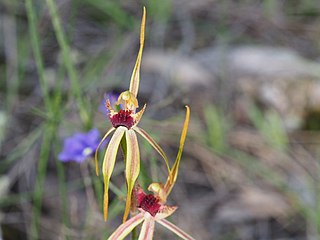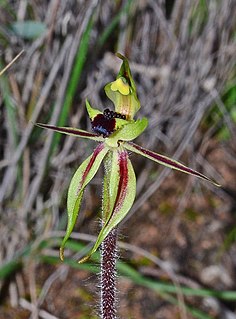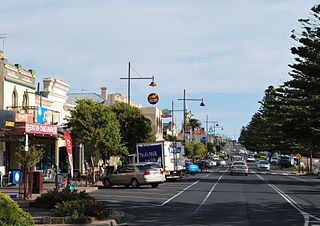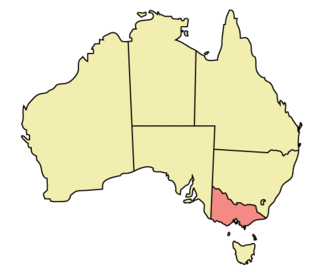Caladenia robinsonii, commonly known as the Frankston spider orchid is a plant in the orchid family Orchidaceae and is endemic to Victoria. It is a ground orchid with a single hairy leaf and one or two red and creamy-yellow flowers with dark red glandular tips on the sepals. In 2010 only about forty specimens of this plant, growing in a single population were known.

Caladenia picta, commonly known as painted fingers, is a species of orchid endemic to New South Wales. It has a single, sparsely hairy leaf and a single white or pink flower with a greenish-white back. Unlike many other caladenias, it flowers in autumn.

Caladenia falcata, commonly known as the fringed mantis orchid, is a species of orchid endemic to the south-west of Western Australia. It is a relatively common orchid within its natural range and has a single, hairy leaf and one or two green, yellow and red flowers with spreading petals and upswept lateral sepals.

Caladenia fragrantissima, commonly known as the scented spider orchid, is a plant in the orchid family Orchidaceae and is endemic to Victoria and South Australia. It is a ground orchid with a single hairy leaf and up to three creamy-white to yellowish-green flowers. It is possible that it is conspecific with Caladenia orientalis.

Caladenia gladiolata, commonly known as small bayonet spider orchid, smelly socks or simply bayonet orchid is a plant in the orchid family Orchidaceae and is endemic to South Australia. It is a ground orchid with a single hairy leaf and one or two yellowish or brownish flowers with red stripes and unusual tips on the sepals and petals.
Caladenia hastata, commonly known as Mellblom's spider orchid is a plant in the orchid family Orchidaceae and is endemic to Victoria. It is a ground orchid with a single hairy leaf and up to three white to cream-coloured flowers with red markings on the labellum.

Caladenia longiclavata, commonly known as the clubbed spider orchid is a species of plant in the orchid family, Orchidaceae and is endemic to the south-west of Western Australia. It is a widespread and common orchid with a single, hairy leaf and one or two greenish-yellow, white and red flowers and which grows in the area between Perth and Albany.

Caladenia phaeoclavia, commonly known as the brown-clubbed spider orchid is a species of orchid endemic to New South Wales. It has a single, hairy leaf and a single light to dark green flower with red stripes and thick, brownish club-like tips on the sepals.
Caladenia radiata, commonly known as the ray spider orchid, is a species of orchid endemic to the south-west of Western Australia. It has a single erect, hairy leaf and one or two green, yellow and red flowers. It flowers more profusely after fire and grows in swampy areas, sometimes flowering whilst in water.

Caladenia rhomboidiformis, commonly known as the diamond spider orchid, is a species of orchid endemic to the south-west of Western Australia. It has a single erect, hairy leaf and one or two green, yellow and red flowers. Until 1971 It was known as a variety of the green comb spider orchid Caladenia dilatata then, until 1989 as a variety of the clubbed spider orchid, Caladenia longiclavata.
Caladenia richardsiorum, commonly known as the little dip spider orchid, Richards' spider orchid or robe spider orchid, is a plant in the orchid family Orchidaceae and is endemic to South Australia. It is a ground orchid with a single erect, hairy leaf and usually only one yellowish-green flower. It is similar to the endangered Mellblom's spider orchid but has a much larger leaf and the petals lack glandular tips.
Caladenia rigida, commonly known as the stiff spider orchid, or white spider-orchid is a plant in the orchid family Orchidaceae and is endemic to South Australia. It is a ground orchid with a single hairy leaf and one or two white flowers with dark glandular tips on the sepals and fine reddish-brown lines along the sepals and petals.

Caladenia septuosa, commonly known as the Koppio spider orchid, is a plant in the orchid family Orchidaceae and is endemic to South Australia. It is a ground orchid with a single erect, sparsely hairy leaf and usually only one greenish-cream flower with red stripes along the sepals and petals.
Caladenia sigmoidea, commonly known as the sigmoid spider orchid, is a species of orchid endemic to the south-west of Western Australia. It has a single erect, hairy leaf and usually only one red and cream-coloured flowers with an unusual S-shaped labellum.
Caladenia stellata, commonly known as the starry spider orchid is a plant in the orchid family Orchidaceae and is endemic to south-eastern Australia. It is a ground orchid with a single, hairy leaf and usually only one greenish-cream flower with red markings.

Caladenia stricta, commonly known as the upright spider orchid or rigid-combed spider-orchid is a plant in the orchid family Orchidaceae and is endemic to southern continental Australia. It is a ground orchid with a single leaf and usually only one pale green flower with red lines along the sepals and petals.

Caladenia toxochila, commonly known as the bow-lip spider orchid is a plant in the orchid family Orchidaceae and is endemic to south-eastern Australia. It is a ground orchid with a single, sparsely hairy leaf and one or two yellowish-green flowers with red stripes. It occurs in Victoria and South Australia and resembles the related Caladenia concinna from New South Wales.

Caladenia uliginosa subsp. uliginosa, commonly known as the dainty spider orchid, or darting spider orchid is a plant in the orchid family Orchidaceae and is endemic to the south-west of Western Australia. It has a single hairy leaf and up to four greenish-cream flowers which have a forward-projecting labellum with a dark red tip.

Caladenia vulgaris, commonly known as summer fingers, or slender pink-fingers is a species of orchid endemic to southern Australia. It has a single, long, erect, hairy leaf and one or two pink or whitish flowers.
Caladenia sanguinea, commonly known as red spider orchid or crimson daddy long-legs, is a species of orchid endemic to South Australia. It has a single sparsely hairy leaf and one or two dark red flowers with long, thin sepals and petals.























